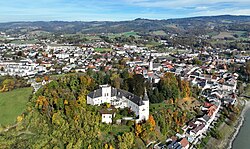You can help expand this article with text translated from the corresponding article in German. (January 2013)Click [show] for important translation instructions.
|
Ottensheim | |
|---|---|
 | |
| Coordinates: 48°20′00″N14°10′37″E / 48.33333°N 14.17694°E | |
| Country | Austria |
| State | Upper Austria |
| District | Urfahr-Umgebung |
| Government | |
| • Mayor | Franz Füreder (Austrian People's Party (ÖVP)) |
| Area | |
• Total | 11.81 km2 (4.56 sq mi) |
| Elevation | 270 m (890 ft) |
| Population (2018-01-01) [2] | |
• Total | 4,721 |
| • Density | 400/km2 (1,000/sq mi) |
| Time zone | UTC+1 (CET) |
| • Summer (DST) | UTC+2 (CEST) |
| Postal code | 4100 |
| Area code | 07234 |
| Vehicle registration | UU |
| Website | www.ottensheim. ooe.gv.at |
Ottensheim is a municipality in the district of Urfahr-Umgebung in the Austrian state of Upper Austria. At its rowing venue, Regattastrecke Ottensheim, it has hosted numerous international rowing competitions, including various World Championships, World U23 Championships, World Junior Championships, and World Cups. [3]

